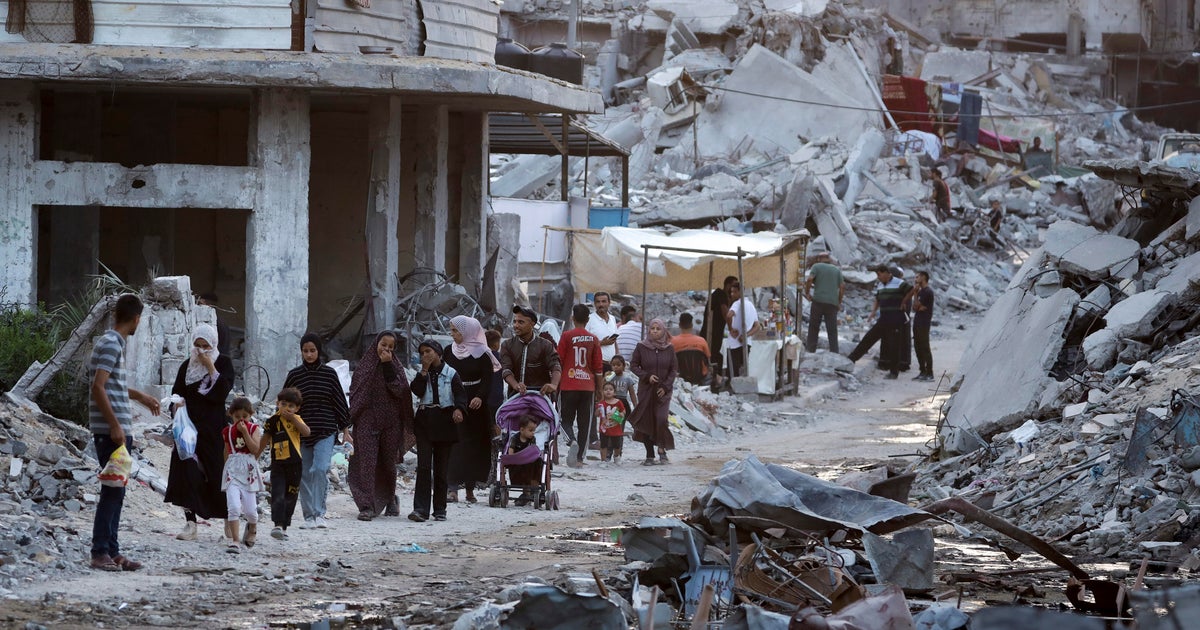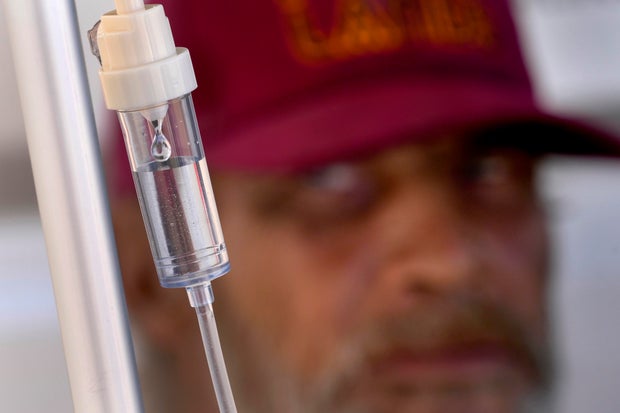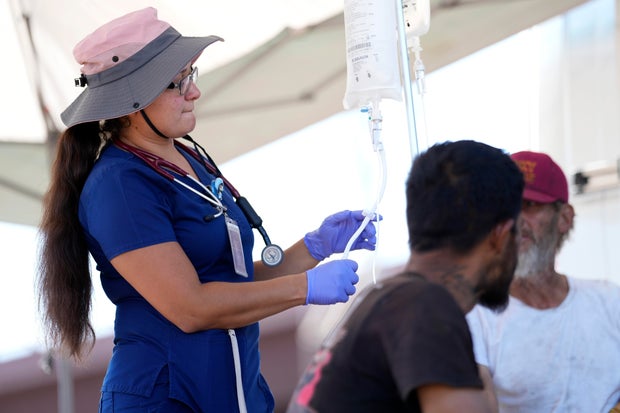CBS News
FDA issues warning about paralytic shellfish poisoning. Here’s what to know.

Before you dig into that platter of freshly shucked oysters or baked clams at your favorite seafood restaurant, better make sure you know from where the shellfish originated.
The U.S. Food and Drug Administration is warning consumers to avoid eating shellfish from Oregon and Washington state because they may be contaminated with toxins that cause what’s known as paralytic shellfish poisoning. At least 31 people have been sickened in Oregon so far, according to state health officials. Here’s what to know about the FDA advisory.
What is the FDA warning about?
The FDA says to avoid oysters and bay clams harvested from Netarts and Tillamook bays in northern Oregon since May 28, as well as shellfish harvested from areas around Willapa Bay in southern Washington since May 26. They may be contaminated with high levels of paralytic shellfish poisoning, or PSP, a naturally occurring toxin produced by algae.
Shellfish harvested from those areas during that period were distributed beyond Oregon and Washington to Arizona, California, Colorado, Hawaii, Nevada, New York. The FDA has warned restaurants and retailers in those states not to serve it.
Elevated levels of toxins were first detected in shellfish on the Oregon coast on May 17, state fish and wildlife officials said.
Since then, a paralytic shellfish poisoning outbreak has sickened at least 31 people in Oregon, according to the Oregon Health Authority. The agency has asked people who have harvested or eaten Oregon shellfish since May 13 to fill out a survey intended to help investigators identify the cause of the outbreak and the number of people sickened.
Oregon authorities have closed the state’s entire coastline to the harvesting of mussels, razor clams and bay clams. Agriculture officials have also closed three bays, including those named in the FDA advisory, to commercial oyster harvesting.
The FDA also urged restaurants and food retailers not to serve or sell oysters and bay clams from growing areas in Netarts Bay and Tillamook Bay,
Officials in neighboring Washington have also closed the state’s Pacific coastline to the harvesting of shellfish, including mussels, clams, scallops and oysters, a a shellfish safety map produced by the Washington State Department of Health shows.
What is paralytic shellfish poisoning?
Paralytic shellfish poisoning, or PSP, is caused by saxitoxin, a naturally occurring toxin that’s produced by algae. Saxitoxin is a neurotoxin, meaning it can damage nerve tissue.
What are symptoms of PSP poisoning?
People who eat shellfish contaminated with high levels of saxitoxins usually start feeling ill within 30 to 60 minutes, according to Oregon health officials. Symptoms include numbness of the mouth and lips, vomiting, diarrhea, shortness of breath and irregular heartbeat in severe cases.
There is no antidote to PSP, according to the health agency. Treatment for severe cases may require mechanical ventilators to help with breathing. In fatal cases, death is typically due to asphyxiation.
But for “patients surviving 24 hours, with or without respiratory support, the prognosis is considered good, with no lasting side effects,” the FDA says.
Due to the range in severity of illness, people should consult their healthcare provider if they suspect that they have developed symptoms that resemble paralytic shellfish poisoning.
Is cooked shellfish safe to eat?
Authorities warn that cooking or freezing contaminated shellfish doesn’t kill the toxins or make it safe to eat.
A “very large” algal bloom has resulted in “unprecedented levels” of PSP toxins along Oregon’s coast, Matthew Hunter, shellfish program manager for the Oregon Department of Fish and Wildlife, said during a briefing.
The toxins have accumulated in the shellfish, sickening some people who have eaten them.
While the factors that create harmful algal blooms are not well understood, certain factors — resulting from both natural processes and human activities — are believed to play a role, according to the National Oceanic and Atmospheric Administration.
“Studies show that many algal species flourish when wind and water currents are favorable,” the agency says on a webpage dedicated to explaining harmful algal blooms. Some blooms, it says, stem from “sluggish water circulation, unusually high water temperatures, and extreme weather events like hurricanes, floods, and drought.”
Algae growth can also increase when nutrients used in fertilizers, mainly phosphorus and nitrogen, flow into bodies of water, according to the agency.
Oregon officials said it may take weeks, months or even up to a year for toxin levels to subside, depending on the type of shellfish.
Mussels can accumulate paralytic shellfish poison rapidly, but also rid themselves of it quickly, according to Hunter, the Oregon fish and wildlife official. Because of this, it may take anywhere from two weeks to a month for mussels to eliminate the toxin.
Razor clams, however, are slower to do so. It may take them several months to a year to cleanse themselves due to the current high levels of toxin, Hunter said.
Such high levels of paralytic shellfish poison haven’t been detected in Oregon in decades, according to Hunter, who cited a previous shellfish harvesting closure in the state in 1992. However, PSP has been prevalent in the regional waters for centuries, he said.
Impact on local fisheries
The harvesting closures may deal a blow to Pacific Northwest fisheries.
Oregon authorities on June qclosed its entire coastline to mussel harvesting after an “unprecedented” outbreak of PSP poisoning sickened at least 20 people. The harvesting of razor clams, bay clams and oysters was also shut down in parts of the coast. Elevated levels of toxins were first detected in shellfish on the state’s central and north coasts on May 17, Matthew Hunter, shellfish program manager for the Oregon Department of Fish and Wildlife, said during a briefing at the time.
Agriculture officials also closed commercial oyster harvesting in Netarts and Tillamook bays on the north coast of Oregon.
The Oregon Department of Agriculture says it will continue testing for shellfish toxins at least twice a month as tides and weather permit. Reopening an area closed for biotoxins requires two consecutive tests that show toxin levels are below a certain threshold, according to the agency.
The shellfish industry generates $270 million each year for the region’s economy, according to the National Oceanic and Atmospheric Administration, and employs some 3,200 people.
CBS News
Street medics treat heat illnesses among homeless people as temperatures rise

Alfred Handley leaned back in his wheelchair alongside a major Phoenix freeway as a street medicine team helped him get rehydrated with an intravenous saline solution dripping from a bag hanging on a pole.
Cars whooshed by under the blazing 96-degree morning sun as the 59-year-old homeless man with a nearly toothless smile got the help he needed through a new program run by the nonprofit Circle the City.
“It’s a lot better than going to the hospital,” Handley said of the team that provides health care to homeless people. He’s been treated poorly at traditional clinics and hospitals, he said, more than six years after being struck by a car while he sat on a wall, leaving him in a wheelchair.
Circle the City, a non-profit that works in multiple cities and hospitals and treats about 9,000 people annually, introduced its IV rehydration program as a way to protect homeless people in Phoenix from life-threatening heat illness as temperatures regularly hit the triple-digits in America’s hottest metro.
Matt York / AP
Homeless people accounted for nearly half of the record 645 heat-related deaths last year in Maricopa County, which encompasses metro Phoenix. As summers grow warmer, health providers from San Diego to New York are being challenged to better protect homeless patients.
Dr. Liz Frye, vice chair of the Street Medicine Institute which provides training to hundreds of healthcare teams worldwide, said she didn’t know of groups other than Circle the City administering IVs on the street. The organization also distributes tens of thousands of water bottles each summer and tries to educate people about hot weather dangers.
“But if that’s what needs to happen to keep somebody from dying, I’m all about it,” Frye said.
Bringing care to people in need
The amount of people requiring treatment for heat illnesses is rising. The Boston Health Care for the Homeless Program, featured in last year’s book, “Rough Sleepers,” now sees patients with mild heat exhaustion in the summer after decades of treating people with frostbite and hypothermia during the winter, said Dr. Dave Munson, the street team’s medical director.
“It’s certainly something to worry about,” said Munson, noting that temperatures in Boston hit 100 degrees with 70% humidity during June’s heat wave. Homeless people, he said, are vulnerable to very hot and very cold weather not only because they live outside, but they often can’t regulate body temperature due to medication for mental illness or high blood pressure, or because of street substance use.
The Phoenix team searches for patients in homeless encampments in dry riverbeds, sweltering alleys and along the canals that bring water to the Phoenix area. About 15% are dehydrated enough for a saline drip.
Matt York / AP
“We go out every day and find them,” said nurse practitioner Perla Puebla. “We do their wound care, medication refills for diabetes, antibiotics, high blood pressure.”
Puebla’s street team ran across Handley and 36-year-old Phoenix native Phillip Enriquez near an overpass in an area frequented by homeless people because it’s near a facility offering free meals. Across the road was an encampment of tents and lean-tos along a chain-link fence.
Enriquez sat on a patch of dirt as Puebla started a drip for him. She also gave him a prescription for antibiotics and a referral to a dentist for his dental infection.
Living outside in Arizona’s broiling sun is hard, especially for people who may be mentally ill or use sedating drugs like fentanyl that make them less aware of their surroundings. Stimulants like methamphetamine contribute to dehydration, which can be fatal. Dr. Matt Essary, who works with Circle in the City’s mobile clinics, said the organization also often treats surface burns that can happen when a medical emergency or intoxication causes someone to fall on a sizzling sidewalk.
Matt York / AP
Temperatures this year have reached 115 degrees in metro Phoenix, where six heat-related deaths have been confirmed through June 22. Another 111 are under investigation, and the city is seeing an “increasing” number of patients with heat illnesses every year, according to Dr. Aneesh Narang, the assistant medical director of emergency medicine at Banner Medical Center-Phoenix, which treats many homeless people with heat stroke.
Narang’s staff works frequently with Circle the City, whose core mission is providing respite care, with 100 beds for homeless people not well enough to return to the streets after a hospital stay.
Extreme heat worldwide requires a dramatic response, said physician assistant Lindsay Fox, who cares for homeless people in Albuquerque, New Mexico, through an initiative run by the University of New Mexico’s School of Medicine.
Three times weekly, Fox treats infections, cleans wounds and manages chronic conditions in consultation with hospital colleagues. She said the prospect of more heat illness worries her.
Highs in Albuquerque can hit the 90s and don’t fall enough for people living outside to cool off overnight, she said.
“If you’re in an urban area that’s primarily concrete, you’re retaining heat,” she said. “We’re seeing heat exposure that very quickly could go to heat stroke.”
Serious heat stroke is far more common in metro Phoenix, where Circle the City is now among scores of health programs for the homeless in cities like New York, San Diego and Spokane, Washington.
Circle the City works with medical staff in seven Phoenix hospitals to help homeless patients get after-care when they no longer need hospitalization. It also staffs two outpatient clinics for follow-up.
Rachel Belgrade waited outside Circle the City’s retrofitted truck with her black-and-white puppy, Bo, for Essary to write a prescription for the blood pressure medicine she lost when a man stole her bicycle. She accepted two bottles of water to cool off as the morning heat rose.
“They make all of this easier,” said Belgrade, a Native American from the Gila River tribe. “They don’t give you a hard time.”
CBS News
Hamas appears to clear way for possible cease-fire deal with Israel after reportedly dropping key demand

There is new hope for a cease-fire deal in the Middle East after Hamas responded to a U.S.-backed proposal for a phased deal in Gaza.
The militant group – which controlled Gaza before triggering the war with an Oct. 7 attack on Israel – has reportedly given initial approval of the cease-fire deal after dropping a key demand that Israel give an up-front commitment for a complete end to the war, a Hamas and an Egyptian official told the Associated Press on Saturday.
A senior U.S. official says that Hamas’ response to the proposal “may provide the basis for closing the deal.”
The apparent compromise could deliver the first pause in fighting since November and set the stage for further talks on ending the devastating nine months of fighting. But all sides cautioned that a deal is still not guaranteed.
The two officials, who spoke on condition of anonymity to discuss ongoing negotiations, told the Associated Press that Washington’s phased deal would first include a “full and complete” six-week cease-fire that would see the release of a number of hostages, including women, older people and the wounded, in exchange for the release of hundreds of Palestinian prisoners. During the 42 days, Israeli forces would withdraw from densely populated areas of Gaza and allow the return of displaced people to their homes in northern Gaza, the officials said.
Over that period, Hamas, Israel and mediators would negotiate the terms of the second phase that could see the release of the remaining male hostages, both civilians and soldiers, the officials said. In return, Israel would free additional Palestinian prisoners and detainees. The third phase would see the return of any remaining hostages, including bodies of dead captives, and the start of a years-long reconstruction project.
Ahn Young-joon / AP
Hamas still wants “written guarantees” from mediators that Israel will continue to negotiate a permanent cease-fire deal once the first phase goes into effect, the officials said.
The Hamas representative told The Associated Press the group’s approval came after it received “verbal commitments and guarantees” from the mediators that the war won’t be resumed and that negotiations will continue until a permanent cease-fire is reached.
“Now we want these guarantees on paper,” he said.
In line with previous proposals, the deal would see around 600 trucks of humanitarian aid entering Gaza daily — including 50 fuel trucks — with half of them bound for the hard-hit northern of the enclave, the two officials said. Following Israel’s assault on the southernmost city of Rafah, aid supplies entering Gaza have been reduced to a trickle.
Israel launched the war in Gaza after Hamas’ October attack in which militants stormed into southern Israel, killed some 1,200 people — mostly civilians — and abducted about 250. Israel says Hamas is still holding about 120 hostages — about a third of them now thought to be dead.
Since then, the Israeli air and ground offensive has killed more than 38,000 people in Gaza, according to the Hamas-run Health Ministry, which does not distinguish between combatants and civilians in its count. The offensive has caused widespread devastation and a humanitarian crisis that has left hundreds of thousands of people on the brink of famine, according to international officials.
Months of on-again off-again cease-fire talks have stumbled over Hamas’ demand that any deal include a complete end to the war. Prime Minister Benjamin Netanyahu has offered to pause the fighting but not end it until Israel reaches its goals of destroying Hamas’ military and governing capabilities and returning all hostages held by the militant group.
Netanyahu’s office did not respond to requests for comment, and there was no immediate comment from Washington.
CBS News previously reported that an Israel delegation headed by Mossad Director David Barnea was traveling to Qatar for talks. Sources told CBS News that Barnea was set to meet with Qatari Prime Minister Sheikh Mohammed bin Abdulrahman Al Thani for discussions.
On Friday, the Israeli prime minister confirmed that the spy agency’s chief had paid a lightning visit to Qatar, a key mediator. But his office said “gaps between the parties” remained.
President Biden held a 30-minute call with Netanyahu on Thursday, a senior Biden administration official told reporters, during which the two leaders walked through the latest draft of the proposal.
U.S. officials have said the latest proposal has new language that was proposed to Egypt and Qatar on Saturday and addresses indirect negotiations that are set to commence during the first phase of the three-phase deal that Mr. Biden laid out in a May 31 speech.
Hamas has expressed concern Israel will restart the war after the hostages are released. Israeli officials have said they are worried Hamas will draw out the talks and the initial cease-fire indefinitely, without releasing all the hostages.
Netanyahu is under pressure from Israel’s closest ally – the United States – to negotiate a ceasefire, but at home, two far-right wing members of his cabinet have threatened to bring down the governing coalition if he agrees to a truce.
Israel bombardment continues
The Hamas-run Interior Ministry said four police officers were killed in an Israeli airstrike Saturday in Rafah, the AP reported. The ministry, which oversees civilian police, said the officers were killed during foot patrol securing properties. It said eight other police officers were wounded. Israel’s military did not immediately respond to questions.
In Deir al-Balah, prayers were held for 12 Palestinians, including five children and two women, killed in three separate strikes in central Gaza on Friday and Saturday, according to hospital officials. The bodies were taken to al-Aqsa Martyrs Hospital, where AP journalists counted them.
Two of those killed in a strike that hit the Mughazi refugee camp Friday were employees with the United Nations agency for Palestinian refugees, the organization’s director of communications told the AP. Juliette Touma said a total of 194 workers with the agency have been killed since October.
Jehad Alshrafi / AP
Earlier this week, an Israeli evacuation order in the southern city of Khan Younis and the surrounding areas affected about 250,000 Palestinians. Many headed to an Israeli-declared “safe zone” centered on the Muwasi coastal area or Deir al-Balah.
Ground fighting has raged in Gaza City’s Shijaiyah neighborhood for the past two weeks, forcing tens of thousands of people to flee their homes. Many have sheltered in the Yarmouk Sports Stadium, one of the strip’s largest soccer arenas.
CBS News
Watch owned by Theodore Roosevelt recovered decades after theft

Watch CBS News
Be the first to know
Get browser notifications for breaking news, live events, and exclusive reporting.













